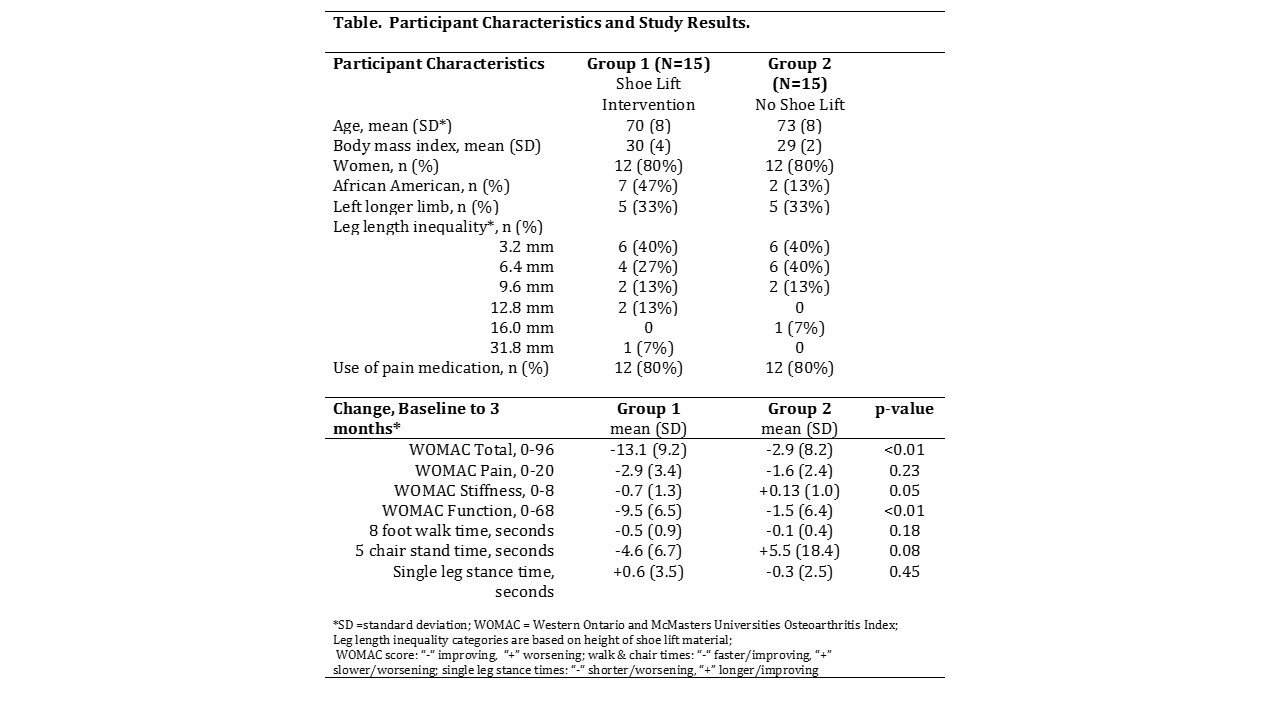Session Information
Session Type: ARHP Concurrent Abstract Session
Session Time: 11:00AM-12:30PM
Background/Purpose: Limb length inequality (LLI; paired
lower extremities of unequal length) is associated with knee and hip
osteoarthritis (OA) and symptoms consistent with OA (pain, aching, stiffness on
most days) in adults. Shoe lifts are effective for treating LLI and low back
pain, but evidence is lacking for their influence on knee or hip symptoms. This
study examined shoe lift therapy as an intervention for LLI and knee or hip
symptoms.
Methods: Thirty participants from a large cohort
study of OA with current knee or hip symptoms, a minimum score of 6 out of 20
on the Western Ontario and McMasters Universities Osteoarthritis Index (WOMAC)
pain subscale, and a LLI ≥ 3.2 mm on radiograph were invited to
participate in a 3-month trial of shoe lift therapy. Anteroposterior pelvic radiographs
were acquired for participants as they stood with equal weight bearing on each
limb with knees extended. The difference in height between the most superior
aspects of the femoral heads was measured in mm to determine the magnitude of
LLI and identify the longer limb. Per protocol, participants began with the
minimum amount of lift material (3.2mm) applied to the shoe of the shorter limb,
and those with a LLI ≥ 6.4 mm had the option of adding lifts in 3.2 mm
increments to their shoes every 7-10 days. The magnitude of lift correction did
not exceed the magnitude of the LLI; otherwise, participants self-selected
their lift based on symptom relief. Participants were randomized to Group 1 (lift
therapy for 3 months) and Group 2 (usual care and brochures on joint pain
management with the option to begin lift therapy after the study period). Participants
completed baseline and 3-month assessments, and the primary outcome was change
in WOMAC score. Secondary outcomes were change in time for the 8-foot walk, time
for 5 repeated chair stands, and single leg stance time. Means and standard
deviations for change in outcomes were calculated and compared using t-tests.
Results: Participant characteristics and study
results are summarized in the Table. Characteristics and baseline outcomes were
similar between groups, except a greater proportion of participants were
African-American in Group 1 than Group 2. All participants completed the 3-month
study, and no adverse events related to lift therapy were reported. WOMAC total
scores declined meaningfully and significantly more in Group 1 than Group 2
(-13.1 vs. -2.9, p<0.01), most notably driven by a decrease in the function
subscale score (an improvement in function). The mean 5 repeated chair stand
times became faster in Group 1 over 3 months, but slowed on average in Group 2
(p=0.08). All participants with 3.2 mm LLI accepted lift correction. Participants
with LLI ≥ 6.4 mm self-selected 25-67% lift correction.
Conclusion: This preliminary study suggests that 3
months of shoe lift therapy with self-selected lift height improves function
among older adults with knee or hip symptoms of OA and LLI.
To cite this abstract in AMA style:
Golightly YM, Gross MT, Nelson , Callahan LF, Jordan JM. Correction of Limb Length Inequality in Adults with Knee or Hip Symptoms: A Pilot Study [abstract]. Arthritis Rheumatol. 2015; 67 (suppl 10). https://acrabstracts.org/abstract/correction-of-limb-length-inequality-in-adults-with-knee-or-hip-symptoms-a-pilot-study/. Accessed .« Back to 2015 ACR/ARHP Annual Meeting
ACR Meeting Abstracts - https://acrabstracts.org/abstract/correction-of-limb-length-inequality-in-adults-with-knee-or-hip-symptoms-a-pilot-study/

